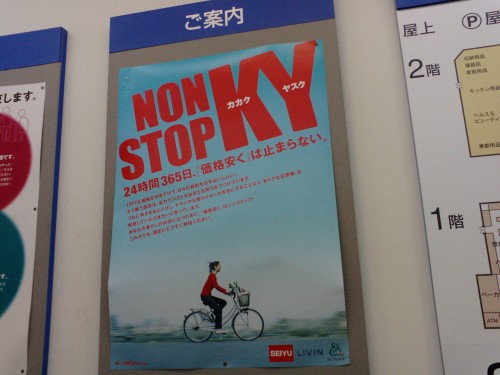(Updated mistranslation “regional” based on reader comment)
In his liveblog of Murakami’s new novel 1Q84, Daniel Morales of Howtojaponese challenged the folks at MFT to find something out for him (emphasis added):
17:03 Done with Chapter 12. No topics on the Aum yet, but religion does come up. Will be interesting to see where he takes it. One question I’d like to see someone answer (maybe someone at Mutantfrog?) is why do so many houses in Japan have signs with Christian quotes on the side? I haven’t seen too many in Tokyo, but they were all over the town where I spent three years. Always the same color pattern – dark brown with yellow lettering. They said things like “The blood of Christ forgives all” or “He died for our sins.” Can’t seem to find a picture anywhere. (Update: Matt provided this link in the comments.)
We at MFT love a good challenge, and thankfully this one wasn’t all that challenging. Thanks to Matt‘s link, I was able to Google my way to the name of the group responsible: It is the Miyagi-based “Bible Distribution Cooperation Society” a loosely organized association of Christians at least partly led by American missionaries. This is one of the same groups who uses soundtrucks and bullhorns in the Shinjuku station area to get out the message of Christ, so those in the know might not be surprised that these signs also come from the American missionaries.
The short answer to Daniel’s question is that this group asks the owners of the house or any other public facade to let them post the signs, and the owners say yes. What follows is the same answer in much more detail, but first let’s give a little background of what we are talking about in case some readers haven’t seen the signs.
The signs
So if you’ve never been to Japan or just not to a part of Japan where the signs are visible, let me clue you in – in various places, mostly in areas outside the major urban centers, you will often see signs that look something like this:
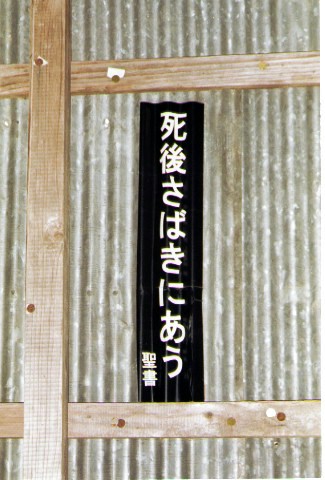
This one reads “After death cometh judgment- The Bible.” According to the site, it is posted on a bus stop near a middle school in Iwate Prefecture. Or this:
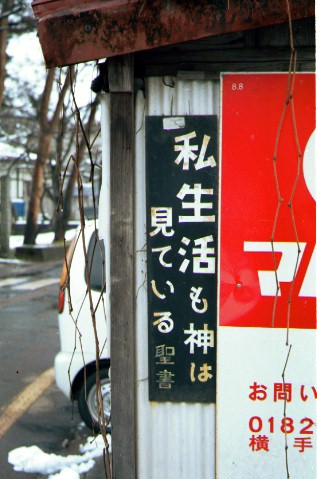
“God is watching, even in your private life – The Bible.” (Taken in Akita Prefecture). Or this:

“The wages of sin is death — The Bible” (Akita Prefecture)
(This site has LOTS more of the signs along with some Jack Chick-style pamphlets and a heaping helping of snarky commentary)
As you can see, they are written in white and yellow text on a black background in uneven, ransom-note fonts and usually contain the starkest of messages about what the God will do to you if you fail to accept Christ. If their intent is to scare the living crap out of people then they are remarkably effective as the signs are truly the stuff of nightmares (or at least a scene out of Carrie or The Texas Chainsaw Massacre). These are not the only public displays in Japan that appear to be judging you on the spot, but they are by far the creepiest I’ve seen. I just don’t understand the point of making these signs so creepy. If you want to make Christianity appealing wouldn’t you try and make people feel welcome instead of scolding them like this?
My personal encounters with the signs come during regular trips to visit inlaws in Tochigi Prefecture, near the Gunma border. Mrs. Adamu, her parents and I usually take backroads to avoid the high tolls, so we get to see several of these signs en route.
At any rate, the placement of these signs on cracked concrete structures and rusted out corrugated aluminum bus stops and storefronts reinforces the general theme of depression and stagnation that dominates the areas I’ve visited. Whenever I see another of these white-on-black reminders that God is watching, it makes me wonder if it is meant as a protest against all the rust and malaise of Tochigi and Gunma.
The group
Now that we know what these signs are, let’s try and answer the next question: who is doing this and why?
According to Wikipedia, these signs are mainly the work of the Bible Distribution Cooperation Society, founded around 1950 in part by an American ex-soldier named Paul Broman who has dedicted his life to spreading the word of God using this unusual method. According to this now-defunct blog of a Japanese Christian minister, Broman took Japanese citizenship in 1970 and funds the activities of the group through his IT services business GrapeCity Inc (UPDATE: Though Broman would be about 82 right now, I haven’t seen an obituary anywhere so I assume he is still alive). According to the group’s website, they initially started their activities in Iwate and Aomori but in the late 1950s expanded internationally. According to Wikipedia, other activities of the group include sound trucks (you may have heard them in Shinjuku) and a Christian school based in Miyagi. They are an independent evangelist group not affiliated with Mormons, Unification Church or any other of the major groups.
Also according to Wikipedia, the signs are posted with the permission of the building/structure owners, and often they are neither a member of the association nor even Christian. They simply allow their real estate to be used for ads, similar to political posters and some other ad schemes, though apparently the association is either not allowed or does not offer to pay in exchange for the permission.
(An aside: This willingness to ugly up the neighborhood I think speaks to the owners’ complete lack of anything resembling taste or the basic decency to maintain an appealing public space. The towns, for their part, also seem to have no interest in keeping their neighborhoods nice. I am sure someone will tell me to shut up and stop making Alex Kerr-style arguments to legislate taste, but in cases like this I have to side with those who’d rather see fewer eyesores)
The association’s official homepage, true to its funder’s background, is well-designed and contains a lot of information, though an uninformed viewer might not immediately recognize that this is the group behind the odd signs and the loud, judgmental announcements in Shinjuku (I’ll accept that maybe the cartoon sound truck at the top of the page gives it away).
On the “About” page, the group’s stated objective is to “directly communicate the word of The Bible” (「聖書のことば」をそのまま伝える」). Their listed activities are distribution of free literature at primary/middle/high schools, “broadcasting” the word of The Bible in areas where many people congregate, individual proselytizing by Christians, and communication of the word of The Bible on placards and signs. They are not a membership organization and do not solicit members. Though the group lends “mutual help” and coordination, each member is individually responsible for his or her activities. Wikipedia indicated that there are apparently other groups who are not affiliated with the original society who have imitated their style. Based on this mission statement I don’t think they would mind imitators.
The group’s activities are completely self-funded and seek no charity. They boast that they have distributed 60 million Bibles to 18 countries throughout their history. They claim to pass out 1 million Bibles in Japan each year.
It is hard to know how many people are involved with these efforts. I am still waiting for an email response from an affiliated group, the Church and Home Educators Association Japan (CHEA Japan). For reference, various estimates count between 1 and 3 million of Japan’s people as at least nominally Christian. Protestants, for their part, comprise around half a million or 0.4% of the population (this is a Wikipedia figure apparently taken from Adherents.org. Like all such estimates it is probably pretty unreliable).
Vintage evangelism
The site also features a photo gallery of the group’s work that includes some vintage signs (unfortunately undated!). Some of these are really cool so I’ll post the best of them:
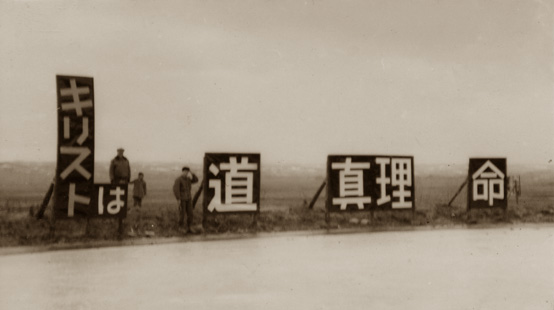
“Jesus is the way, truth, life.”
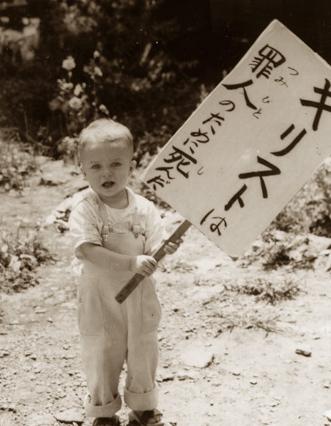
“Christ died for the sinners.”
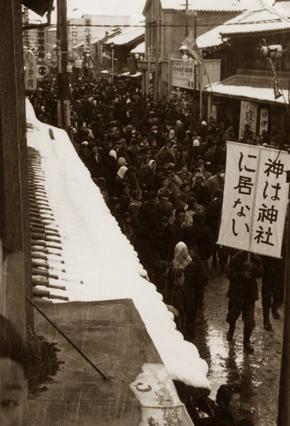
“God is not in the shrine.”

“After death cometh judgment.”
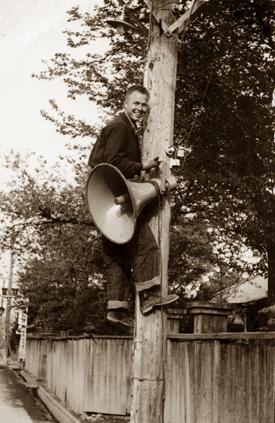
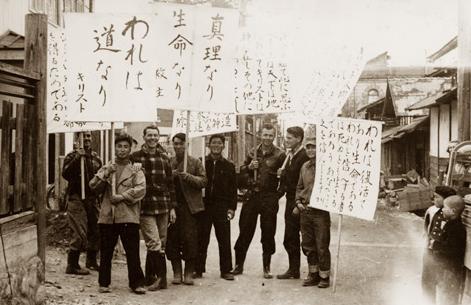
Front: “I am the way.”
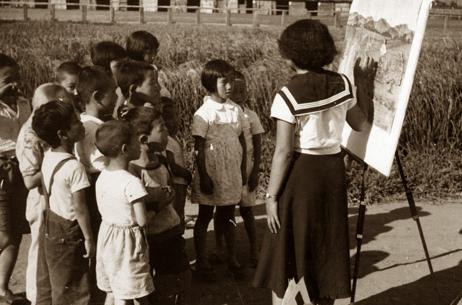

John 3:16 – “For God so loved the world, that he gave his only begotten Son, that whosoever believeth in him should not perish, but have everlasting life.”

“The blood of Christ, God’s only son, purifies all our sins – The Bible.”
There are lots more on the site, so I advise you to check them out!
Fun with Christian signs
These signs have become something of an underground social phenomenon due their sheer ubiquity (in Japanese some refer to them as キリスト看板 or roughly “those Christian signs”). One site (linked from Wikipedia) lets you create your own scary signs in HTML. Here is my version of Nietsche’s “God is dead” quote:

 Google’s commemorative logos have become a tradition over the years starting from simple doodles to more complex pieces,
Google’s commemorative logos have become a tradition over the years starting from simple doodles to more complex pieces, 












